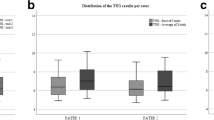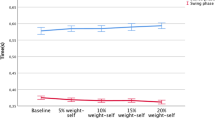Abstract
The purpose of this study was to investigate whether participation in sensorimotor activities by preschool children involving their own bodily balance while walking on a beam over the floor has an effect on their understanding of the mechanical equilibrium of a balance beam. The balance beam consisted of a horizontal stick balancing around its center of mass (middle point), while carrying equal-weight objects on either side of it. The study utilized a two-group design, and was conducted in three phases (pre-test, treatment and post-test). The results of the study provide evidence that there was such an effect, since the children (who participated in the sensorimotor activities) could select out of a number of objects those two with the same weight regardless of their shape, size or colour, in order to balance the stick. This effect also can be seen when a comparison is made with a second group of children, which had previously participated in a hands-on activity regarding the equilibrium of a similar balance beam, and which (children), therefore, had a definite advantage over the other children who had participated in the sensorimotor activity. A Chi Square Test showed no significant differences between the two groups on both an immediate and a delayed post-test, while the McNemar Test for the Significance of Change showed a statistically significant difference (that is, a negative change in performance between the first and the second post-test) only within the hands-on group. This difference represents evidence that the children from the sensorimotor group remembered better the rule they were applying (i.e., selecting equal-weight objects) in order to balance the beam.

Similar content being viewed by others
References
Ausubel, D., Novak, J., & Hanesian, J. (1978). Educational psychology: A cognitive view. New York: Holt, Rinehart & Wilson.
Beer, R. D. (2000). Dynamical approaches to cognitive science. Trends in Cognitive Sciences, 4, 91–99.
Berlucchi, G., & Aglioti, S. (1997). The body in the brain: Neural bases of corporeal awareness. Trends in Neurosciences, 20, 560–564.
Bidell, T., & Fischer, K. (1993). Beyond the stage debate. In R. Sternberg, & C. Berg (Eds.) Intellectual development (pp. 98–142). Cambridge, MA: Cambridge University Press.
Bruner, J. (1966). Toward a theory of instruction. Cambridge, MA: Harvard University Press.
Bredekamp, S., & Copple, C. (Eds). (1997). Developmentally appropriate practice in early childhood programs. Washington, DC: National Association for the Education of Young Children.
Cassell, J., Sullivan, J., Prevost, S., & Churchill, E. (2000). Embodied conversational agents. Cambridge, MA: MIT Press.
Clarck, A. (1999). Embodied, situated, and distributed cognition. In W. Bechtel, & G. Graham (Eds.) A companion to cognitive sciences (pp. 506–517). Malden, MA: Blackwell.
Clark, A. (1997). Being there: Putting brain, body, and world together again. Cambridge, MA: MIT Press.
Cohen, L., Manion, L., & Morrison, K. (2000). Research methods in education. London: Routledge.
Dourish, P. (2001). Where the action is: The foundations of embodied interaction. Cambridge, MA: MIT Press.
Duncker, L., Scheunpflug, A., & Schultheis, K. (2005). Schulkindheit. (Children during their school years). Stutgartt: Kohlhammer.
Egan, K. (1997). The educated mind: How cognitive tools shape our understanding. Chicago: University of Chicago Press.
Egan, K. (2006). Somatic understanding: Our body’s role in our intellectual development. Paper presented at the 4th International Conference on Imagination and Education. Simor Fraser University, Vancouver, Canada, 2006, July.
Epelboim, J. (1997). Deictic codes, embodiment of cognition, and the real world. Behavioral and Brain Sciences, 20, 746.
Gardner, H. (1993). Frames of mind: The theory of multiple intelligences (Rev. ed.). New York: Basic Books.
Glenberg, A. (1999). Why mental models must be embodied. In G. Rickheit & C. Habel (Eds.), Mental models in discourse processing and reasoning pp. 77–90. New York: Elsevier.
Hadzigeorgiou, Y. (1987). The development of a rationale for the teaching of Newtonian mechanics. Unpublished Masters Thesis, School of Education, University of Leeds, Leeds, UK.
Hadzigeorgiou, Y. (1994). Conceptual representation of the Newtonian model of motion in university physics students. Unpublished Doctoral Dissertation, Department of Curriculum and Instruction, College of Education, University of N. Iowa, Cedar Falls, IA, USA.
Hadzigeorgiou, Y. (2002a). The utilization of sensorimotor experiences for introducing young children to molecular motion: A report of a pilot study. Physics Education, 37, 239–244.
Hadzigeorgiou, Y. (2002b). A study of the development of the concept of mechanical stability in preschool children. Research in Science Education, 32, 373–391.
Hadzigeorgiou, Y., & Savage, M. (2001). Α study of the effect of sensorimotor activities on the understanding and retention of two fundamental physics ideas. Journal of Elementary Science Education, 31, 9–23.
Hadzigeorgiou, Y., & Stefanich, G. (2003). A study of the effect of sensorimotor activities on the understanding of action and reaction by third grade students. Unpublished document, School of Education, University of the Aegean, Rhodes, Greece.
Hannaford, C. (1995). Smart moves. Why learning is not all in your head. Arlington, VA: Great Ocean.
Hardiman, P., Pollatsek, A., & Well, A. (1986). Learning to understand the balance beam. Cognition and Instruction, 3, 63–86.
Ito, M. (1993). Movement and thought: identical control mechanisms by the cerebellum. Trends in the Neurosciences, 16, 448–450.
Johnson, M. (1987). The body in the mind: The bodily basis of meaning, imagination, and reason. Chicago: The University of Chicago Press.
Kamii, C., & DeVries, R. (1993). Physical knowledge in preschool education. New York: Teachers College Press.
Kitchener, K. (1986). Piaget’s theory of knowledge. New Haven: Yale University Press.
Lakoff, G., & Johnson, M. (1999). Philosophy in the flesh: The embodied mind and its challenge to western thought. New York: Basic Books.
Mak, B., & Vera, A. (1999). The role of motion in children’s categorization of objects. Cognition, 7, 11–21.
Markman, A., & Dietrich, E. (2000). In defense of representation. Cognitive Psychology, 40, 138–171.
Mithen, S. (2000). The prehistory of the mind: The cognitive origins of art, religion and science. New York: Thames & Hudson.
Montessori, M. (1967). The absorbent mind. New York: Barnes.
Piaget, J. (1971). Genetic epistemology. New York: Norton.
Port, R., & van Gelder, T. (1995). Mind as motion. Explorations in the dynamics of cognition. Cambridge, MA: MIT Press.
Ravanis, C., Koliopoulos, D., & Hadzigeorgiou, Y. (2004). What factors does friction depend on? A socio-cognitive intervention with young children. International Journal of Science Education, 25, 997–1007.
Roth, W. M. (1991). The development of reasoning on the balance beam. Journal of Research in Science Teaching, 28, 631–644.
Searson, R. (2001). The learning-style teaching model. Science and Children, 38, 22–26.
Seitz, J. (1993). I move.... therefore I am. Psychology Today, 26, 50–55.
Seitz, J. (2000). The bodily basis of thought. New ideas in Psychology, 18, 23–40.
Siegler, R. (1976). Three aspects of cognitive development. Cognitive Psychology, 8, 401–520.
Sternberg, R., & Berg, C. (1993). Intellectual development. Cambridge: Cambridge University Press.
Thelen, E. (1995a). Motor development: A new synthesis. American Psychologist, 50, 79–95.
Thelen, E. (1995b). Time-scale dynamics in the development of an embodied cognition. In R. Port, & T. Van Gelder (Eds.) Mind in motion. Cambridge: MIT Press.
Thelen, E., & Smith, L. (1994). A dynamic systems approach to the development of cognition and action. Cambridge, MA: MIT Press.
Thelen, E., Schoner, G., Scheier, C., & Smith, L. B. (2001). The dynamics of embodiment: A field theory of preservative reaching. Behavioral and Brain Sciences, 24, 1–34.
Varela, F., Thompson, E., & Rosch, E. (1991). The embodied mind. Cambridge, MA: MIT Press.
Wilson, M. (2001). The case for sensorimotor coding in working memory. Psychonomic Bulletin and Review, 8, 44–57.
Acknowledgment
The author wishes to thank the three anonymous reviewers for their insightful comments on the first draft of this paper.
Author information
Authors and Affiliations
Corresponding author
Rights and permissions
About this article
Cite this article
Hadzigeorgiou, Y., Anastasiou, L., Konsolas, M. et al. A Study of The Effect of Preschool Children’s Participation in Sensorimotor Activities on Their Understanding of the Mechanical Equilibrium of a Balance Beam. Res Sci Educ 39, 39–55 (2009). https://doi.org/10.1007/s11165-007-9073-6
Received:
Accepted:
Published:
Issue Date:
DOI: https://doi.org/10.1007/s11165-007-9073-6




